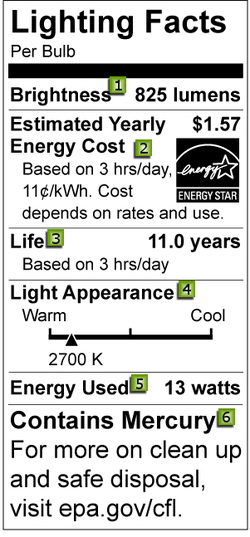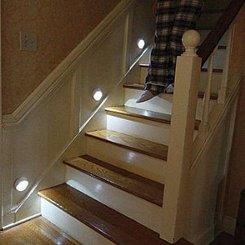In most cases, an occupancy sensor can be added to your low voltage lighting kit to supplement and further enhance the practical and aesthetic features in many ways. Often these lighting kits are installed and then frequently ignored because they are not essential lights for everyday activity. But if they are controlled by an occupancy sensor switch they will automatically turn on when the space is occupied and turn off when the area is vacant for a designated amount of time.
Controlling a low voltage lighting system with an occupancy sensor is an extravagant and energy efficient addition to a variety of low voltage lighting applications around your home. Low voltage lighting is becoming increasingly popular in DIY home projects and renovations because it is inexpensive, low maintenance, and easy to install. While it can be used in practical applications such as security lighting, under cabinet lighting or to illuminate trip hazards in a dark backyard patio, it is also used as accent lighting in bookshelves, cabinets, and gallery spaces.
In most cases, an occupancy sensor can be added to your low voltage lighting kit to supplement and further enhance the practical and aesthetic features in many ways. Often these lighting kits are installed and then frequently ignored because they are not essential lights for everyday activity. But if they are controlled by an occupancy sensor switch they will automatically turn on when the space is occupied and turn off when the area is vacant for a designated amount of time.
2 Comments
 There are many automated lighting systems on the market today. Each company that develops their own 'unique system' seeks to sell you not only their product but a lifetime obligation to their services. First, the system will have to be installed by one of their professionals and then you must pay to 'unlock' new features. All the while, the cost effectiveness of an automated lighting system seems to go out the door. So before you commit to a state of the art product and service, consider building your own automated lighting system with individual components. If well executed you can create a luxurious, convenient lighting system on the cheap that will provide energy savings for years to come.
First you must become familiar with what technology is out there. There several types of wireless communications, two in particular are most commonly used in lighting. The first is infrared technology. Infrared light is electromatic radiation that has a wavelength longer than visible light. These wavelengths are communicated by a corresponding frequency range. Each frequency communicated signals a different function or command to the end user lighting component. The other type of wireless communication is a wireless local area network (WLAN) or Wi-Fi. Each component within the automated lighting system will have an IP address on a network and transmit communications resulting in lighting controls and responses. The main benefit of Wi-Fi communications over infrared is that communications are relayed over the network and each component can send signals both forward and backward. Also all activities can be monitored by a base station on the network. This could be your home computer with Wi-Fi access or your smart phone. The base station logs onto the network and can monitor all signals being transmitted and even schedule activities. This is very helpful in creating an automated lighting system. Now you can shop for lighting components that communicate on one of the two platforms and start to assemble a unique one of a kind lighting system. One lighting component that is crucial to any lighting system is an occupancy sensor. While occupancy sensor switches are not ideal for all spaces and applications they can automatically turn lights off when not needed in areas of your home or office where you usually leave the lights on. This will help you save tons of money on your energy bills. Occupancy sensors are available to fit in a wall switch junction box or for a ceiling mounted application. There are also a variety of lamps and LED fixtures that come fitted with occupancy sensors built-in. This option adds an extra dimension of flexibility to your DIY automated lighting system design; allowing you to place sensored lighting in areas where conduit had never been installed. These are interesting times for those who enforce energy standards across the United States. Building codes and ordinances are similar to any other laws enforced by the judicial system in that they exist on several levels.There are international building codes, federal and state building codes, and even local building codes and ordinances. While each set of regulations has similar fundamental characteristics, one can see variance according to a particular region's energy initiatives.
Energy efficiency initiatives are they driving force behind changes in building codes to become more stringent on energy consumption. While Germany, Denmark, and Switzerland remain some of the most energy efficient countries, the United States struggles to keep up. One state that is pushing energy efficient initiatives far more than others is California. The results are proven by a measure of per capita energy consumption. California's per capita energy consumption is 50% less than the average of all other states. One large contributing factor to California's energy efficiency achievements is the Title 24, Part 6 of the 2008 Building Energy Efficiency Standards. These standards meet and exceed federal Energy Star standards for many categories of building code requirements. One category that is strongly enforced in terms of energy efficiency is lighting, section 150(k). There are many reasons to use occupancy sensors in your home or office. They can add convenience and luxury to any space at an affordable price. However the most popular reason to install occupancy sensor switches is to increase a building's energy efficiency and save the owner money. It is always cost effective to install occupancy sensors, but this guide will help determine the most cost effective automated lighting plan using occupancy sensors in your home or office. With the help from historical statistics from the EPA, the Energy Efficient Lighting Supply has identified the most cost effective spaces to install occupancy sensors. Click below to view the guide.
Motion-activated path lights combine the technology of an occupancy sensor with high output, low consumption LED lights. Path lights can be hardwired with a low voltage power source or battery powered for flexible design and ease of installation. In each case, occupancy sensing or motion-activated path lights are convenient way to add useful lighting to a space while saving
energy. Path lights are specifically designed to light up dark corridors or stairwells which rarely see natural light, even in the daytime. Rather than wiring extra light fixtures to light these areas and inconvenience with you with light switches which we tend to leave on when not needed, occupancy sensing pathlights will turn themselves on or off when needed and not needed. This is not only a luxury but also a safety feature to add to your home or backyard. Consider how many times you find yourself shuffling around in a dark hallway looking for a light switch. With motion-activating path lights there is no need to dangerously walk around un-lit stairwells anymore. Motion-activating path lights also add a modern and futuristic look that is sure to blend in with and spice up even the most conventional decor. Here are several examples of where you can use occupancy sensing path lights to add convenience, safety, and luxury to your living spaces. 1. Stairwell or Hallway- Of course, this is the most popular use for occupancy sensing pathlights. Path lights will turn on one by one as an occupant ascends or descends your dark hallway. This safety feature looks luxurious and is sure to add flare to an otherwise boring space. 2. Outdoor stairs- Outdoor pathways often include stairs to adjust elevation changes in the terrain. These stairs are often trip hazards in areas that are not always lit. Trust motion-activated path lights on each riser to detect an occupant when he or she is six feet away and light up the stairs. 3. Under Cabinet Lighting- Install motion activated path lights in your kitchen to light up shaded work spaces under your upper wall cabinets. This alternative to traditional LED under cabinet lighting can save even more energy and look even cooler as it lights up only the counter top space that you are using. 4. Gallery lighting- Add an extra dimension to the artwork in your home. As occupants walk by to observe hanging artwork a motion activated path light mounted over your painting or series of paintings is sure to draw them in and bring your artwork to life. 5. Closet spotlights- Closets in older homes and even some newer homes are rarely wired for lighting. And if they are, occupants are constantly leaving the closet light on! Never leave the closet light on again with occupancy sensing path lights over each section of clothing. This will make getting up and picking out your clothes fun and easier than ever. An occupancy sensor is a small electronic component, about the size of a light switch, that can detect the presence or absence of occupants in a space, thus turning the lights they are controlling on or off. There are two main types of occupancy sensors; one uses passive infrared technology while the other uses ultrasonic technology.
Passive Infrared sensors detect heat energy in a room. By sending an array of infrared lasers from its location in a room it can detect when one crosses the ‘line of sight’ of the sensor. These sensors are very appropriate for locations where traffic is unobstructed by objects, but also spaces that are not too open. According to the National Lighting Product Information Program, passive infrared occupancy sensors detected medium sized motion in an open space office area at 35% of the locations. This data does not reflect the effectiveness of passive infrared technology but rather the planning required to appropriately place these sensors based on the technology they use. In the same study, ultrasonic occupancy sensors were also tested. The results revealed that medium sized motion was detected at 98% of the locations. Ultrasonic occupancy sensors works similar to a submarine’s sonar technology. The ultrasonic sensor sends high frequency waves that return to the sensor after traveling across a space. Once irregularities of these patterns occur, the sensor is triggered. Once activated, the lights will turn on, and once the wave patterns return to a static state for a certain time the lights will turn off. Ultrasonic occupancy can be used in more locations than passive infrared occupancy sensors because the waves they send out can move around barriers while infrared lasers are calibrated to static position. Most ceiling mounted occupancy sensors use ultrasonic waves. Applying these occupancy sensors to an automated lighting setup in an open office area is very effective. The waves are capable if returning occupancy based information with in subdivided areas by partitions or a traditional cubicle setup. When integrating occupancy sensors into a cost effective automated lighting design, one should consider the usage of both types. While the ultrasonic is useful in more locations, it also ranges from 15%-33% more expensive than a passive infrared occupancy sensor. For this reason a cost efficient design will have passive infrared sensors where acceptable and ultrasonic sensors in other locations. Automated lighting controls come in various forms. How they are each implemented into your home or office and how they work with one another will determine the effectiveness of your energy efficient lighting system. Many new forms of automated lighting controls aim to take advantage of information shared by new utility sponsored programs called the "smart grid".
In essence, smart grid technology takes a network of data from power plant production to regional and final end user consumption, and reports who is using how much energy, where and when. With this type of information power plant operations can distribute power accordingly without increasing peak production. From the end user's standpoint, our homes and offices, we can access this same information to determine when electricity will cost the most and respond accordingly. But more effectively, companies have taken the initiative to develop automated demand response lighting controls that eliminate the need for human response. At the same time they enable the user to easily override the controls and set their own preferences. While demand response lighting controls can be used by residential consumers to dim lights in specific areas during peak demand, they are most effective in commercial office applications. To illustrate the potential savings of switching your traditional incandescent light bulbs to LED light bulbs or other energy efficient light sources, Energy Efficient Lighting Supply has created the Annual Energy Savings Calculator. All you have to do is type in the watt rating of your current light bulb, the watt rating of a comparable LED light bulb, and how long the light will be on each day. The calculator does the rest and immediately reports the amount saved per year in energy costs.
 On a recent trip to buy light bulbs, you may have noticed a label on light bulb packaging that looks strikingly similar to the nutrition facts label on items at the grocery store. This new label, regulated by the Federal Trade Commission, is designed to help consumers choose the correct light bulb based on criteria pertaining to lighting quality and energy consumption. For years, consumers have purchased light bulbs based on the wattage or power consumption and the capacity of the fixtures the bulb would be installed in. This traditional rule of thumb is actually backwards, and only applicable to incandescent light bulbs. In an effort to produce more energy efficient and long lasting products, the lighting industry has produced different light sources that install in your traditional fixtures, but, because of varying technical attributes, produce different levels of light output that do not directly correlate to wattage. After all, the purpose of an energy efficient light bulb is to produce the same quality of light while having a lower wattage (power consumption). This how-to guide will introduce the facts on the lighting label and how to make sense of them. 1. Brightness- Perhaps the most important piece of information on the lighting facts label is the measured amount of light emitted by a light source. It is measured in lumens, which can be further understood with knowledge of the unit of foot-candles. However, as a rule of thumb for consumers, a 60 watt incandescent light bulb produces about 890 lumens. Using this basis, energy efficient lighting decisions can be made according to light production not power consumption. 2. Estimated yearly energy cost- This fact is very self-explanatory as stated on the label. It can be useful when comparing two labels side-by-side because the cost for each will be associated with the same amount of daily usage for the year. This number varies with usage per day and your utility rates. As utility rates increase your annual savings compared to a less efficient light bulb will increase as well.
3. Life- Pertains to the average life of the product based on 3 hour per day usage. The light bulb can last longer or shorter based on daily use. It is important to consider this number when comparing estimated yearly energy costs among light bulbs. On an economic basis, the replacement cost associated with the life of the light bulb will impact the cost effectiveness of your purchase more than the yearly energy costs associated with using the light bulb. 4. Light Appearance- The label portrays light appearance on a kelvin scale of warm to cool. This refers to the color temperature of all visible light. The warmer the light the more yellow or orange it appears, a cooler light bulb will appear white and almost have a tint of blue in it. This aspect of the label has no association with efficiency of the light bulb but can be very useful to a consumer. In general, warm lights are desired for interior use in living spaces as ambient lighting. Cooler light appearance is desired for outdoor use or in kitchens or workspaces where high color temperature comparable to natural daylight is desired. 5. Energy Use- A Watt is the unit for power and refers to the energy consumption of a light source. The lower the number the more energy efficient the light bulb is. As said before, this number has no universal indication of how bright a light source will be. 6. Contains Mercury- This note represents that improper disposal of the light bulb can be an environmental hazard. A lot of people don’t understand that even though compact fluorescent lights (CFLs) are considered environmentally friendly because they use less energy, they still contain mercury. For proper disposal procedures visit epa.gov/cfl as indicated on the label. This detailed "how to" from Lutron will guide through the steps involved with installing your wall switch occupancy sensor. Be sure to switch the breaker to the circuit you will be working on before performing any work. With a screw driver and hardware supplied with your occupancy sensor switch, you can be on your way to saving energy in only 15 minutes! | |||

 RSS Feed
RSS Feed